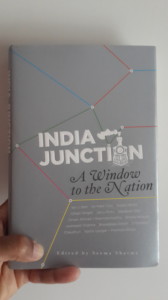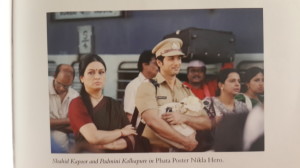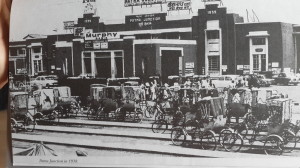Book review: India Junction – A Window to the Nation
(An edited version of the review appeared in the Sunday Express dated July 20, 2014)
This may not exactly be the most opportune time for a book on the Indian Railways, by the Indian Railways, what with the political and passenger angst around the recent fare hike. Then, there may not be a more suitable time either – despite all the allied brouhaha, public awareness on what ails the chugging behemoth is on a never-before high. Reasons and recommendations be divided facts are staring harsh and hard right in the face: To break even, fares need to be increased by not less than 50 per cent! With even a nominal knowledge of economics one can realise how skewed the current tariff system is when the passenger fares are cross-subsidised from freight fares. This not only is detrimental to freight movement by trail but also translates to roadblocks in expansion and modernisation of service for the traveller. The share of railways vis-à-vis roadways in inter-regional freight traffic has come down from almost 90 per cent in 1951 to around 30 per cent today – a fall that has cost the Indian economy close to 40,000 crore rupees so far. Today the environment angle has become quite critical to be overlooked: Compared to roads, railways uses 75 to 90 per cent less energy for freight traffic and up to 20 per cent less energy for passenger traffic. And then there is also that niggling matter of national pride, security even: Due to inadequate finances the Indian Railways network has expanded by a mere 1,600 kilometres over the last decade; China, during the same period, created a network of 10,000 kilometres, that too of high-speed rail! The rollback in the fare hike might be premature but the timing of India Junction – A Window to the Nation is just fine. But what the book actually commemorates – and celebrates – is the Railways completing 160 years of service to the nation – right from its role in spreading nationalism to eventual nation building.
An anthology of well-researched essays from big daddies of India history like Mark Tully and Ian J. Kerr among others, India Junction also features some delightful (train) travel writing and a section on photographs, some rare and amazing; mixing up the information offensive with the travelogues comes like the much-needed ‘kaapi’ after all the ‘vegetable biryani’. Tip: Alternate essay with travelogue.
The essays: In the opening chapter Mark Tully while presenting wagonloads of rail history in his trademark engaging objectiveness furthers the argument as to the true beneficiaries of the Indian Railways – from a historical perspective – being the school between the meliorists and immiserationists. Kerr, in ‘Imagining the nation’ argues that railways was – and remain – an instrument of capitalist development; in a marked detour from the economics of it all presents some hard statistics favouring rail transport over road in regard to the environment. Mahatma Gandhi’s train travels soon after his arrival from South Africa is, understandably, a recurring theme with the essayists drawing on the momentous pan India journey, undertaken following the advice of Gopal Krishna Gokhale, variously to portray the furtherance of nationalism with the advent of railways or to reflect the progressive transformation and eventual acceptance of the railways as a symbol of national prosperity and modernity. In the latter context Kerr quotes Gandhi’s take on train travel during the early days, ‘Good travels at a snail’s pace – it can, therefore, have little to do with the railways’.
Gillian Wright, partner and long-time collaborator of Mark Tully, talks about the heritage of both locomotives – most of which are now in either of the railway museums in Delhi or Rewari – and of the landmark railway terminuses spread across India and their architectural histories in ‘A 160-year heritage’. Her vivid descriptive detailing make you wonder how you missed them; the authority and passion with which the iconic bridges are brought to life make you want to ride over them, again, eyes wide open this time. Her second chapter ‘The Magic of Hill Railways’ presents some delightful nuggets like how the Z-shaped reverse stations, an engineering triumph, could have been inspired by the ballroom dancing lessons of the engineer’s wife. You can cull out a marvellous must-see list too from the chapter. The romance of rail travel is not lost on the fact-grinding, history-crunching writers who, at times, veer towards the sublime. Sharmila Kantha, while talking about the political and economic impact of the Railways, cannot help but resist a ‘Today when we see a train chug past us, we all feel a tug of emotion and a thrill while we wonder which parts of our vast land it will traverse.’ ‘The Spirit of the Railways’ is a tribute to the exemplary courage and fortitude of railway employees in resuming service in the aftermath of every dastardly act of terrorism or natural calamity. A truly inspiring piece, an ode to fortitude, definitely, but it fails to strike a chord on a personal level – the narrative just skims over the surface of incidents and people with none of these everyday heroes fleshed out adequately. Everybody who grew up in the 70s can relate to Jerry Pinto’s ‘Railways’ Filmy Chakkar’ – a nostalgic delight which starts with his own reminiscences of journeying with his parents and sister, buying film magazines and raucously ‘leaking’ the gossip stories to the roles train play in the movies. After some top-heavy chapters, this one comes like the first calls of ‘halwa’ as you near the Palakkad Junction when you enter Kerala from the arid plains of Tamil Nadu. Pinto is spot-on about our fascination with trains: ‘They were our road movies, our rail movies.’
The travelogues: Ruskin Bond’s ‘When the train came to Deyra Dhoon’ starts off like one of the author’s popular children’s tales but soon musters track and goes on to capture the various nuances – with its follies – of the Raj high life. Omair Ahmad’s train journey has elided the two major joys of rail travel – the eclectic mix of fellow passengers and the diorama unravelling outside the window – choosing to introduce lengthily two books – as interesting as they may be – instead. Considering he was journeying into Bhutan – a route I’d taken many years ago – it was a let-down. ‘The most important thing when travelling by train in India is the size of your neighbour’s tiffin carrier’ – Shoba Narayan’s opening lines sets the tone and pace of her sojourn from many years ago, a burp-happy juxtaposing of regional culinary delicacies over a more personal narrative. ‘Aboard the Vivek Express’, an account of the longest single train journey in India, by Asheesh Sharma, is an informative and above all engaging account of behind-the-berth working of a train. ‘Changing Lanes’ by Kartik Iyengar is about a chance meeting aboard a train that not only changed the writer’s life but got him a co-author and a mentor and even a tax auditor! Mommies might want to rethink before they go ‘Don’t talk to strangers’ again. When Kartik says the best thing about train journeys was the lack of signals making you incommunicado, I don’t know many who would disagree. Save for some history forced into the descriptive, Premola Ghose’s ‘Kangra: The land of the white mountain’ is an engaging account of the exotic sounding – and looking – stations along the Kangra Valley Railway ride from Pathankot to Joginder Nagar. After Wright, this one had me taking notes for a soon-to-be itinerary. The photography section is not much to toot about except for the ‘Blast from the past’ series which, unfortunately, is just six. The others including ‘Filmy Chakkar’ are at best page three material. ‘Railnama’ barely passes muster above your average street photography.
Apart from some avoidable edit errors – prominent industrialist of pre Independent India Dwarkanath Tagore mentioned variously as father and grandfather of Nobel laureate Rabindranath – minor digressions though, like unscheduled stops, India Junction is a sure-shot like the omnipresent station-staple poori-sabzi filling in varying degrees of delectability. You don’t have to be a trainspotter to fit this one into your collection, a passing interest in travel or history or even numbers will work just fine. Sample this:
115,000 km: Total track kilometres of the Indian Railways
7,000: Number of stations, big and small
14 lakh: Staff
125: Hospitals belonging to and wholly supported by the Railways
2,500: Number of doctors
The proposed corporatisation of the Indian Railways comes with carte-blanche powers where politics of appeasement – even of the junta – will have no say. India Junction thus in a way also primes us for the next fare hike which is not too far away.
Featured image courtesy of Sunday Express














